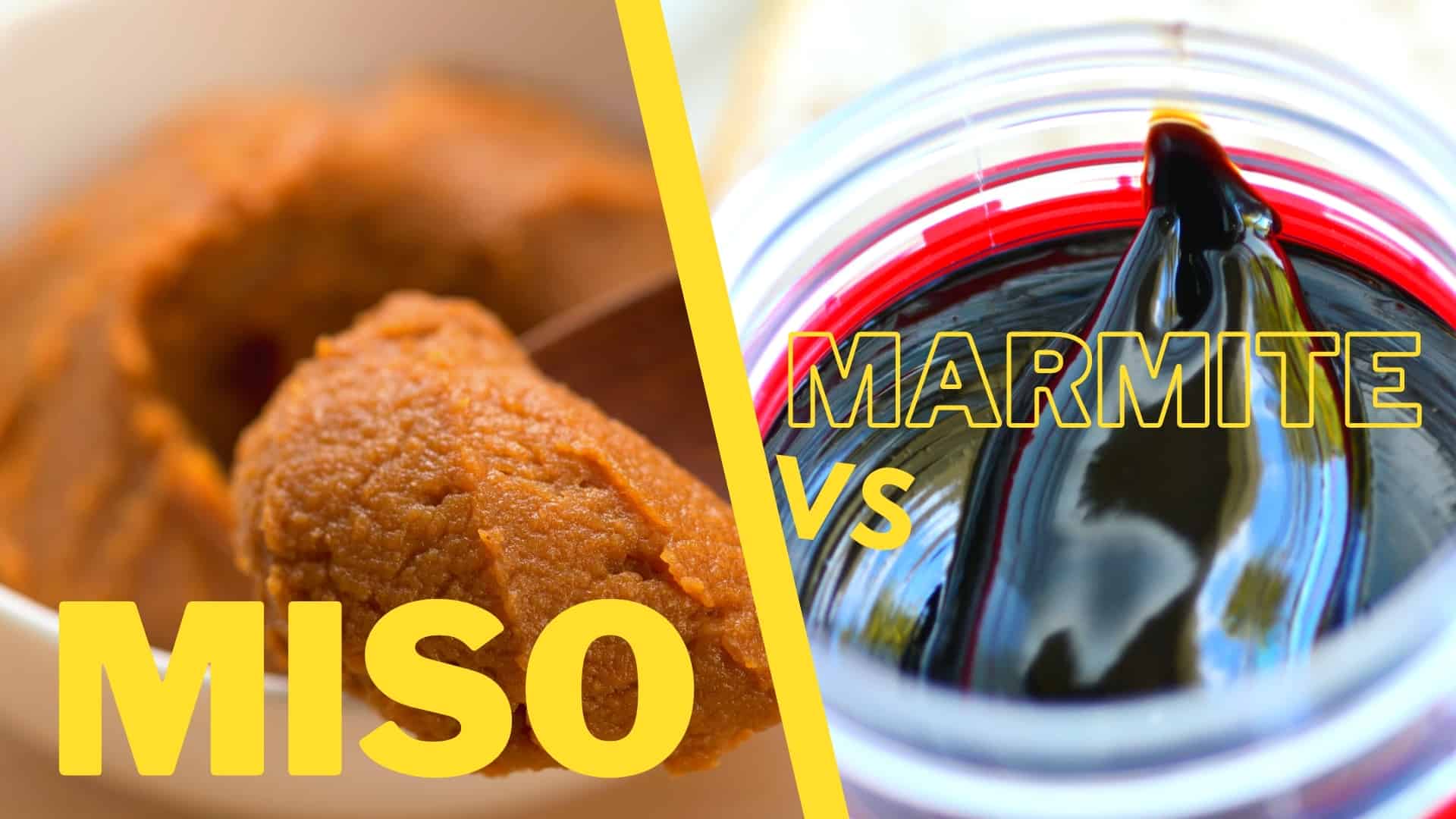Miso vs. Marmite | How to Use Both + Differences Explained
If you look at the latest culinary news, you will see that marmite is being advertised as the new miso.
Both foods are fermented, can work as spreads, and have a great umami flavor.
But they have their share of differences.

This article will look at miso and marmite giving you an understanding of both foods so you can decide which you prefer.

Check out our new cookbook
Bitemybun's family recipes with complete meal planner and recipe guide.
Try it out for free with Kindle Unlimited:
Read for freeIn this post we'll cover:
What is Miso?
Miso is a traditional Japanese seasoning product. It is made with fermented soybeans, koji, and salt.
Sometimes rice, barley, seaweed, and other ingredients are added as well.
It creates a thick paste that can be used in sauces, dips marinades, and as a condiment.
It is commonly mixed with dashi to make miso soup.
Don’t confuse miso paste with soybean paste! Miso Paste vs. Soybean Paste | Differences & How To Use Both.
What is Marmite?
Marmite originated in Britain but was invented by a German.
It is made from the yeast leftover from beer which is then converted into a high protein byproduct.
The result is a thick, salty, funny tasting paste-like substance with an unusual aroma. Some love it and some hate it but there is no doubt that it’s an acquired taste.
Marmite was traditionally used as a breakfast food, often spread on toast in the morning like butter and jelly.
More recently, it’s become widely used in other culinary applications. It can be added to stews, casseroles, and even sweets to produce a deep umami flavor.
Miso vs. Marmite: Nutrition
Both miso and marmite have several health benefits.
Because they are fermented, they work as probiotics offering benefits for the digestive tract.
Here are some other nutrition facts.
Miso Nutritional Benefits
Miso is rich in vitamins and minerals including protein, vitamin K, manganese, copper, and zinc.
In addition to being beneficial to digestion, it may also prevent certain forms of cancer and boost the immune system.
Marmite Nutritional Benefits
Marmite is low in calories and high in riboflavin, niacin, thiamine. It also has a decent amount of B12, folate and iron.
It is believed to be helpful in the treatment of conditions such as cold, flu and diarrhea and diabetes.
It is beneficial to metabolism and it helps the heart, nerves and muscles function properly.
Miso vs. Marmite: Best Brands
If you are looking to buy marmite or miso, here are some brands with products that are worth checking out.
Miso Best Brands
- Miko Awase Miso Soybean Paste: This is an authentic Japanese product that tastes great in soup.
- Smart Miso Sweet Light Miso: This is a vegan product that is non-GMO and does not contain any MSG. It is shelf-stable, easy to use, and naturally aged.
- Marukome Miso & Easy: This is a soup concentrate product. Its packaging makes it easy to use.
Marmite Best Brands
Marmite is both a type of food and a brand.
Therefore, there are not many options when it comes to purchasing it.
- Marmite Yeast Extract is great for spreading on toast. It is 100% vegetarian and rich in B vitamins. It is also available in squeeze bottle form.
- It may be sacrilege to some, but Vegemite Yeast Extract is quite similar to Marmite. Invented as a competitor for Marmite, it’s mostly popular in Australia.
Miso vs. Marmite: Recipes
If you are looking to make recipes using marmite or miso, here are a few you can choose from.
Miso Recipe Ideas
- Ginger Grilled Miso Asparagus: Miso works well as a marinade for green beans and other veggies.
- Shredded Chicken Salad with Creamy Miso Dressing: Combine lettuce and bacon with a creamy miso dressing for a light and tasty meal.
- Pecan-Miso Butter and Jelly Sandwiches: Just how it sounds, mix pecans with miso and add jelly for an unusual take on peanut butter and jelly sandwiches.
Marmite Recipe Ideas
- Marmite Glazed Nuts and Seeds: Glazing nuts and seeds in marmite will make this healthy snack totally addictive.
- Marmite Hollandaise: Adding marmite to hollandaise gives it an almost cheesy flavor.
- Marmite and Cheddar Muffins: Cheddar and marmite in muffins? It’s just as delicious as it sounds.
Now that you know more about these two spreads, how will you be using them to take your recipes to the next level?
Did you know miso can be a great substitute for Worcestershire Sauce?
Check out our new cookbook
Bitemybun's family recipes with complete meal planner and recipe guide.
Try it out for free with Kindle Unlimited:
Read for freeJoost Nusselder, the founder of Bite My Bun is a content marketer, dad and loves trying out new food with Japanese food at the heart of his passion, and together with his team he's been creating in-depth blog articles since 2016 to help loyal readers with recipes and cooking tips.

